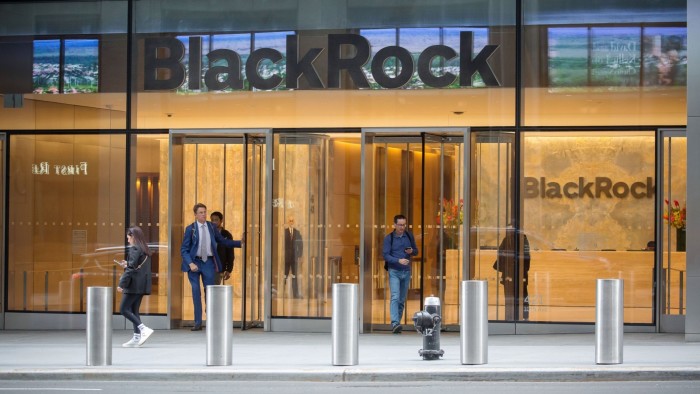BlackRock says investors set to face 5.5% long-term borrowing costs

Simply sign up to the US interest rates myFT Digest -- delivered directly to your inbox.
The world’s largest asset manager sees benchmark US borrowing costs hovering around 5.5 per cent for the next five years as investors grapple with inflationary pressures.
Ten-year yields are at 4.56 per cent, but Jean Boivin, head of the BlackRock Investment Institute and a former deputy governor of the Bank of Canada, said markets were heading for much higher long-term borrowing costs. These would come from ageing populations, fractious geopolitics and costs associated with the energy transition, he said.
“We think 5.5 per cent long-term 10-year yields in the US is the level that seems consistent with the macro backdrop in the next five years,” Boivin told the Financial Times. “It’s also consistent with the compensation for risks that bond investors should require to invest in long-term bonds.”
The comments follow a sharp rally in government bonds on both sides of the Atlantic in recent days as conviction has grown that central banks have reached the end of their interest rate raising cycles.
Ten-year US Treasury yields dropped by 0.28 percentage points this week. Wednesday’s fall was the biggest daily decline since the collapse of Silicon Valley Bank in March, following what investors saw as dovish remarks by US Federal Reserve chair Jay Powell. They sunk by almost as much again on Friday after softer than expected US payrolls data.
Powell said the Fed was committed to achieving a policy stance that was “sufficiently restrictive to bring down inflation to 2 per cent”.
But BlackRock’s Boivin expressed doubts about the US central bank’s chances of succeeding. “We see inflation on a rollercoaster: falling now but then starting to unsettle some time after next year,” he said, adding that he expected to see inflation “closer to 3 per cent in the US over the next couple of years”.
The headline US inflation rate has fallen from June 2022’s peak of 9.1 per cent to 3.7 per cent in September.
Boivin did not have strong conviction on the prospects of the Fed delivering one more rate increase but said the bigger story was when the central bank would start to cut rates. Expectations for the timing of the first cut have been pushed back by about six months since the summer as investors accept that rates will stay higher for longer.
Futures markets have priced the first cut for July next year, but Boivin said he believed a rate cut next year would come “in late 2024, if at all”.
Boivin said economies across Europe and the US were normalising from pandemic-induced inflation to a world with ongoing inflationary pressures.
“We talk about a world being shaped by supply rather than a world shaped by demand, which was the case between 1980 to 2020,” he said, citing crucial drivers including “ageing populations leading to tight labour markets, geopolitical fragmentation making global production more expensive and the energy transition meaning a more expensive energy mix”.
Other large asset managers have shared lingering concerns about inflation. “We are not out of the woods yet,” said Tiffany Wilding, managing director at bond investment house Pimco. “If you characterise the disinflation we are seeing, it’s basically pandemic effects fading,” she said. “Once we have pandemic-related distortions fade, where is the underlying trend in inflation? That’s what we’re still unsure about.”
But some investors see sufficient signs that the Fed could succeed at bringing inflation close to its target level.
“Wages, given the potential growth rate of the economy, are roughly consistent with a 2 per cent target,” said Tomasz Wieladek, chief European economist at T Rowe Price, as was “very strong manufactured goods disinflation as a result of normalising global supply chains”.
Following months of strong US economic data, much weaker than expected manufacturing figures this week were another factor that pushed Treasury yields lower.
While Boivin said he thought 10-year yields would settle at about 5.5 per cent over the next five years, he expected that level could take six to 12 months to reach given the surge in yields that has already happened this year.
In a world where 10-year yields are persistently close to 5 per cent, BlackRock calculates that the costs for servicing US debt at its current level would be about 14 per cent of the country’s budget. That sum, Boivin pointed out, is greater than the amount the country spends on Medicare, the taxpayer-funded healthcare plan for retirees.
“I think it will put significant pressure on governments and the US,” Boivin said. “The fiscal implications of these rates is going to be a big story — I don’t think it has been digested yet by markets or by governments.”
Comments